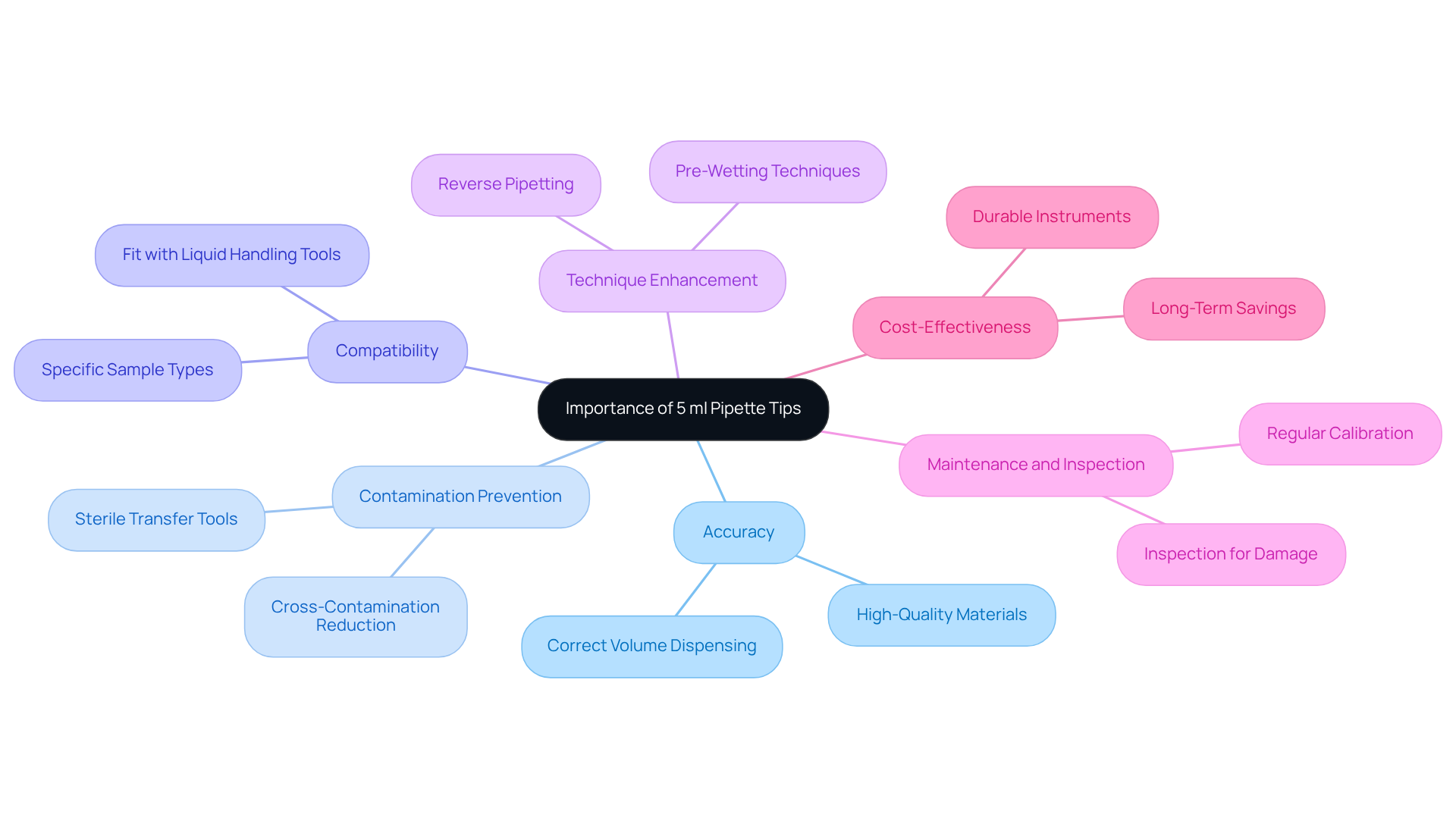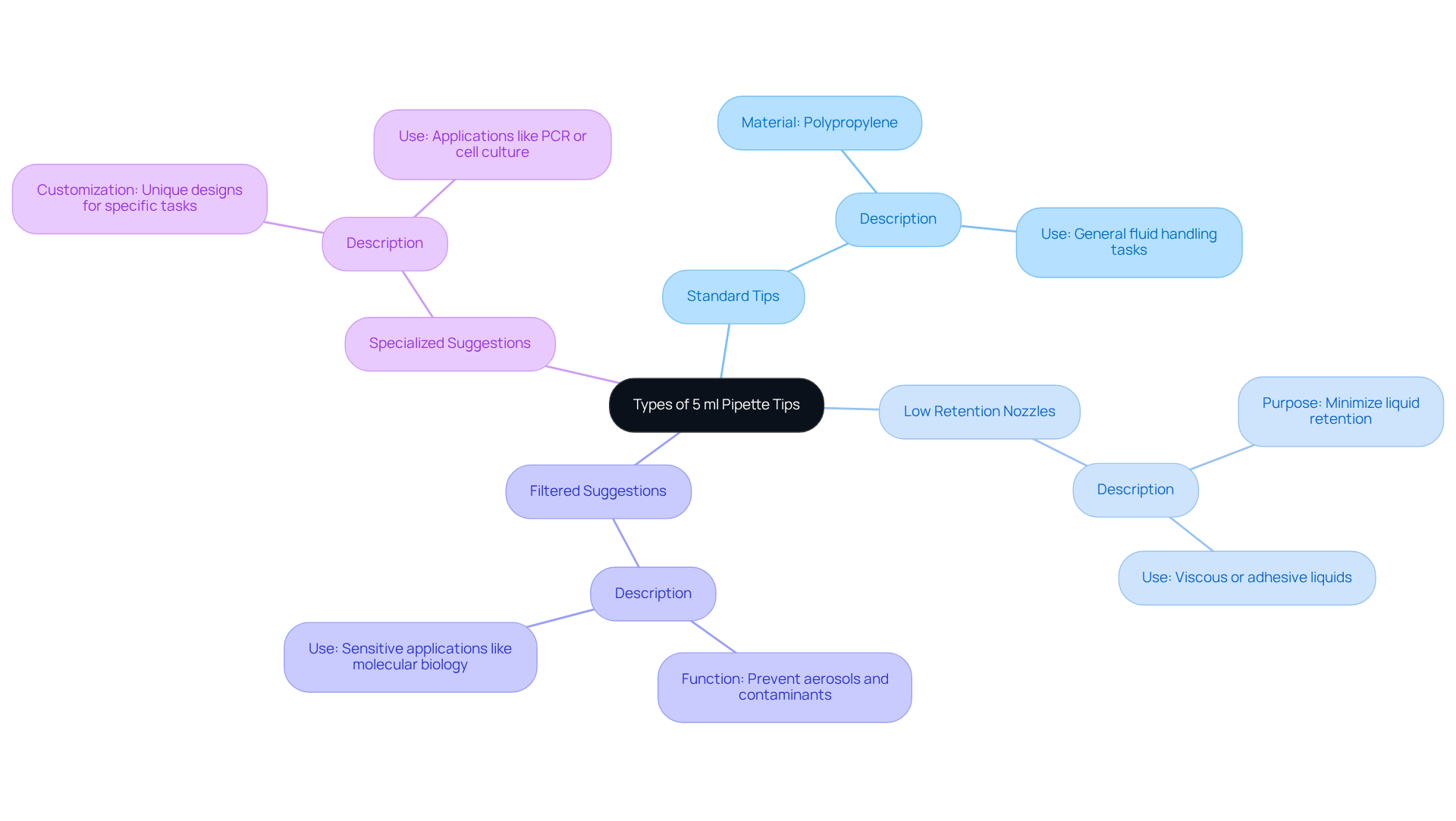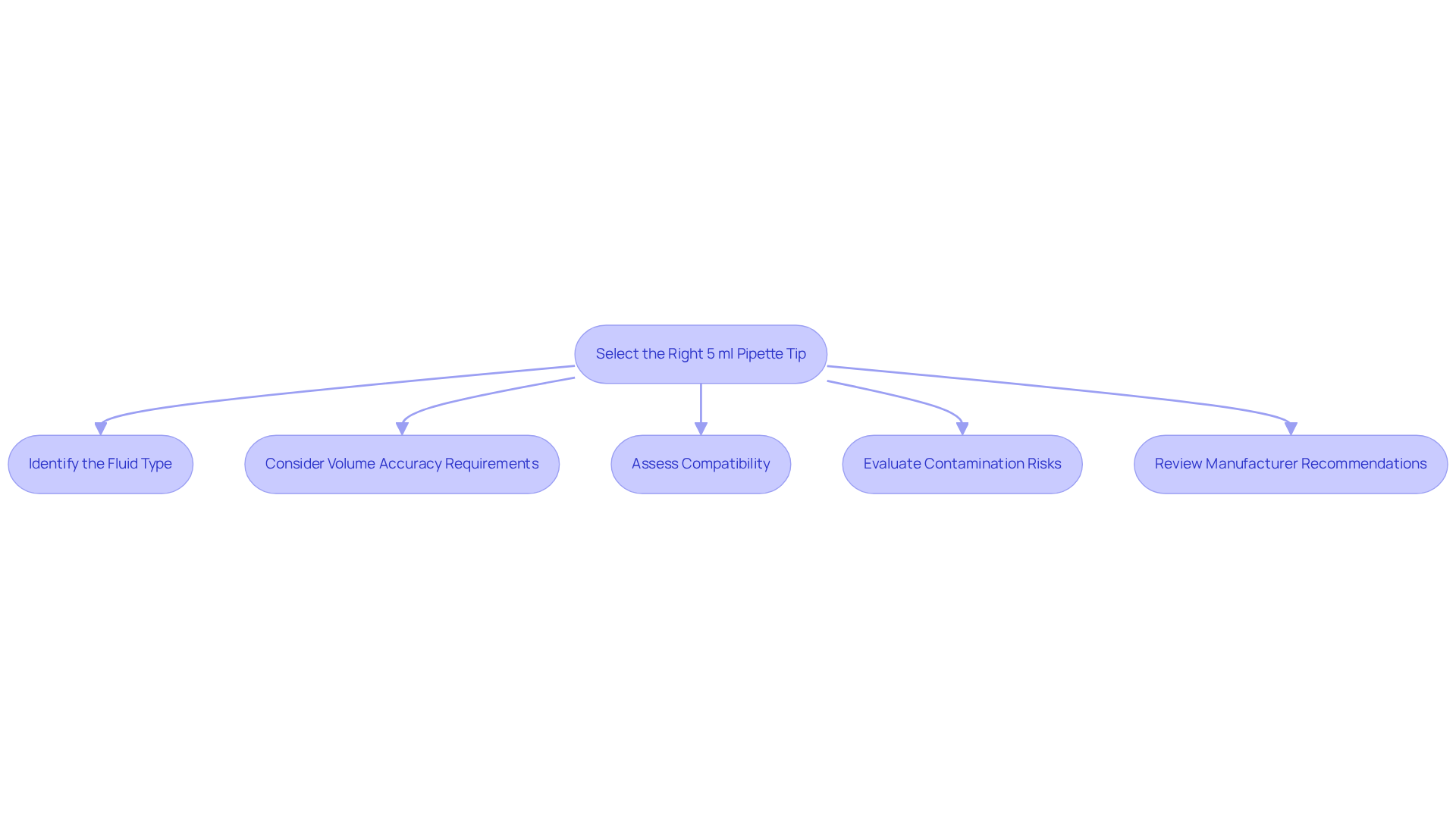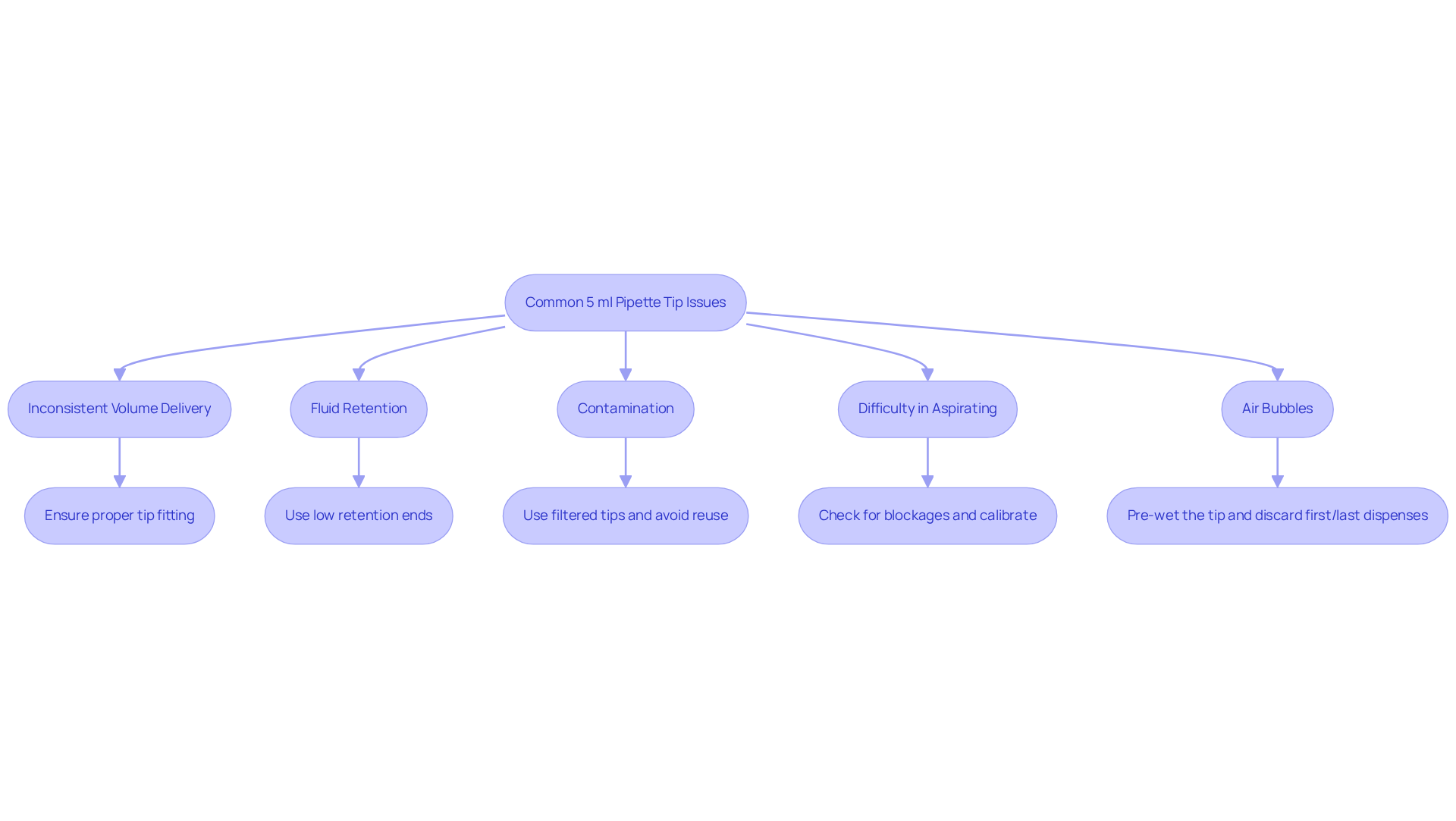Overview
This article underscores the critical role of selecting the appropriate 5 ml pipette tips in optimizing laboratory performance. By ensuring accuracy, preventing contamination, and enhancing technique, the right tips are essential for achieving reliable and precise experimental results. It elaborates on the various types of tips available, detailing their specific applications and best practices for troubleshooting common issues. Such insights are vital for researchers aiming to elevate their experimental outcomes and maintain the integrity of their work.
Introduction
In the intricate world of laboratory work, the precision of fluid measurements significantly hinges on the selection of the right pipette tips, particularly the versatile 5 ml options. These essential tools facilitate accurate liquid transfer and play a crucial role in preventing contamination, ensuring consistent experimental outcomes.
However, researchers face a challenge: how can they navigate the myriad of available options to select the most suitable pipette tip for their specific applications? This guide delves into the nuances of 5 ml pipette tip selection, offering insights designed to enhance laboratory performance and elevate the reliability of scientific results.
Understand the Importance of 5 ml Pipette Tips in Laboratory Work
In laboratory settings, the selection of disposable ends is vital for ensuring the precision and reliability of fluid measurements. Specifically, 5 ml pipette tips are commonly employed for transferring liquids across a range of applications, including chemical analyses and biological assays. The careful selection and application of these recommendations are essential for preventing contamination, ensuring consistent volume delivery, and minimizing experimental errors. Understanding the significance of these guidelines is crucial for refining pipetting techniques and achieving optimal laboratory performance.
Key reasons for their importance include:
- Accuracy: Choosing the appropriate tip ensures that the correct volume is dispensed, which is essential for reproducibility in experiments. High-quality laboratory consumables, made from virgin polypropylene, significantly reduce sample retention and enhance measurement accuracy.
- Contamination Prevention: Using high-quality instruments reduces the risk of cross-contamination between samples, which is critical for maintaining the integrity of experimental results. For instance, sterile transfer tools are indispensable in sensitive procedures such as cell culture, where contamination can compromise outcomes.
- Compatibility: Various liquid handling tools are specifically designed for certain models, ensuring a secure fit that optimizes performance. This compatibility is essential, as utilizing the incorrect type of tip can result in inaccurate measurements or contamination.
- Technique Enhancement: Employing techniques like reverse pipetting can aid in managing excess material when working with viscous substances, further improving accuracy. Additionally, pre-wetting the nozzle of the instrument can prevent dripping, particularly with volatile liquids.
- Maintenance and Inspection: Regular calibration and maintenance of liquid handling devices are crucial for achieving accurate sampling. Inspecting liquid transfer devices for damage prior to use is also vital to ensure measurement precision.
- Cost-Effectiveness: Investing in durable, high-quality dispensing instruments can yield long-term savings, making them a prudent choice for research facilities.
By acknowledging these factors, research personnel can make informed decisions that significantly enhance their experimental outcomes, ultimately supporting the reliability and success of their scientific endeavors.

Explore Different Types of 5 ml Pipette Tips
5 ml dispensing points, such as the 5 ml pipette tip, are essential instruments in research environments, available in various types tailored for specific uses and fluid properties. Understanding these distinctions is vital for selecting the most appropriate tip for your needs. The primary types include:
-
Standard Tips: The most commonly used, standard tips are made from polypropylene and are compatible with the majority of pipettes. They are ideal for general fluid handling tasks, making them a staple in many laboratories.
-
Low Retention Nozzles: Designed specifically to minimize liquid retention, low retention nozzles excel in managing viscous or adhesive liquids. This design ensures maximum sample recovery, which is critical in applications where every drop counts. As industry specialist Swapna Singh notes, 'The growth of the market for sampling devices is fueled by rising demand in molecular biology, which is expected to have a favorable impact on market revenue growth throughout the sampling devices market forecast period.'
-
Filtered Suggestions: These suggestions come equipped with a filter that prevents aerosols and contaminants from entering the pipette, making them suitable for sensitive applications such as molecular biology and diagnostics. Their use is increasingly important in environments where contamination could compromise results.
-
Specialized Suggestions: Customized for distinct laboratory tasks, specialized components may feature unique designs, such as extended lengths or specific shapes, tailored for applications like PCR or cell culture. These suggestions are crafted to meet the specific requirements of various experimental protocols.
Familiarizing yourself with these types of sampling tools will enable you to make the most suitable choice for your tasks, ultimately enhancing precision and productivity in your work. Furthermore, the global tips market is projected to grow to USD 1.8 billion by 2033, underscoring the increasing importance of these instruments in research environments.

Select the Right 5 ml Pipette Tip Based on Your Application
Selecting the right 5 ml pipette tip is essential for achieving optimal laboratory performance. Here’s a structured approach to guide your decision-making:
- Identify the Fluid Type: Assess whether you are handling aqueous solutions, viscous substances, or volatile materials. Low retention strategies are particularly effective for thick substances, significantly reducing sample loss.
- Consider Volume Accuracy Requirements: For applications demanding high precision, filtered or low retention dispensers are recommended. These options ensure minimal liquid loss and enhance accuracy. The market for laboratory tools is projected to expand from $2.28 billion in 2024 to $2.46 billion in 2025, underscoring the rising significance of selecting appropriate instruments in this growing market.
- Assess Compatibility with Your Liquid Handling Device: Verify that the selected attachments are suitable for your specific model to avoid operational problems and ensure dependable performance. It is advisable to utilize pipette attachments from the same manufacturer as the pipette to minimize the need for recalibration and improve reliability.
- Evaluate Contamination Risks: When handling delicate samples, using filtered utensils is essential to prevent contamination and preserve sample integrity. Filtered tips help mitigate aerosol contamination, which is critical for maintaining the quality of your results.
- Review Manufacturer Recommendations: Always consult the manufacturer's guidelines for specific applications. These insights are invaluable for ensuring optimal performance.
By adhering to these guidelines, you can confidently select the most suitable 5 ml pipette tip for your tasks, thereby enhancing the reliability and precision of your results. As noted by the National Institute of Standards and Technology (NIST), the market for laboratory automation equipment, including liquid handling systems, experienced a growth rate of 12% annually between 2021 and 2023, highlighting the importance of effective liquid handling in modern laboratories.

Troubleshoot Common Issues with 5 ml Pipette Tips
Even with established best practices, challenges can arise when utilizing a 5 ml pipette tip. Common problems include inconsistent volume delivery, fluid retention, contamination, difficulty in aspirating, and air bubbles, each with effective solutions that can significantly enhance laboratory performance.
Inconsistent Volume Delivery: This issue often arises from improper tip fitting or the use of incompatible tips. It is essential to ensure that the 5 ml pipette tip is securely attached and specifically designed for your device model. Statistics reveal that up to 30 percent of pipettes in service may not perform within expected tolerances, underscoring the importance of proper tip selection. Inaccuracies as minute as one microliter can critically impact laboratory tests, making precision paramount.
Fluid Retention: If fluid remains in the tip after dispensing, consider employing low retention ends, designed to mitigate this problem. Practical examples show that transitioning to these specialized tips can significantly improve fluid delivery precision, particularly with thick solutions.
Contamination: To avert contamination, utilize filtered tips and refrain from reusing tips across different samples. This practice is vital for maintaining sample integrity, especially in sensitive assays where even minor contamination can lead to erroneous results.
Difficulty in Aspirating: If the device struggles to draw fluid, inspect for blockages in the tip or verify that the instrument is calibrated correctly. Regular calibration is crucial, as improper calibration can lead to substantial inaccuracies in volume delivery. The impact of pipetting errors is often underestimated; even slight discrepancies at the bench can accumulate, resulting in significant inaccuracies in your data.
Air Bubbles: To eliminate air bubbles, pre-wet the tip by aspirating and dispensing liquid before taking your actual measurement. This technique stabilizes the air cushion within the pipette, ensuring more accurate volume transfers. Furthermore, discarding the first and last dispenses during repeat dispensing helps eliminate inconsistencies in pipetting volume.
By recognizing these common issues and implementing the suggested solutions, you can significantly enhance the performance of your laboratory work and ensure reliable results.

Conclusion
Selecting the appropriate 5 ml pipette tips is not just a matter of preference; it is essential for achieving optimal performance in laboratory settings. The precision and reliability of fluid measurements depend heavily on this choice. The right tips can significantly enhance experimental outcomes while minimizing errors and contamination risks. By grasping the importance of these instruments, researchers can refine their techniques and uphold the integrity of their results.
In this article, we have explored key aspects such as:
- Accuracy
- Contamination prevention
- Compatibility
- Technique enhancement
The discussion highlighted the various types of 5 ml pipette tips, including standard, low retention, filtered, and specialized options, each tailored for specific applications. A structured approach to selecting the right tip based on fluid type, accuracy requirements, and contamination risks serves as a comprehensive guide for researchers. Additionally, troubleshooting common issues related to pipette tips underscores the importance of proper usage and maintenance in achieving reliable results.
Ultimately, the careful selection and application of 5 ml pipette tips not only improve laboratory performance but also support the broader goals of scientific research. By investing time in understanding and implementing best practices, researchers can ensure their findings are both accurate and reproducible. Embracing these strategies will enhance individual experiments and contribute to the advancement of scientific knowledge as a whole.




